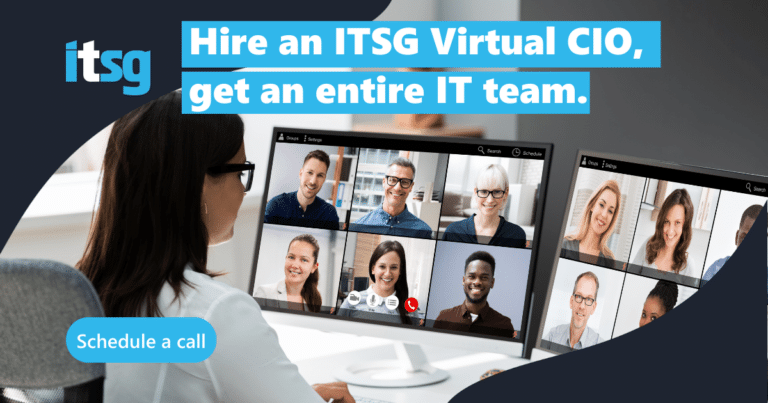The owner and/or CEO of your average small to mid-sized business is often spread too thin. When starting a business from the ground up, it is their vision that drives recruitment, sales, operations, and everything beyond.
The execution of that vision is what grows a business, but eventually, that weight becomes too much for one person to bear. The day-to-day will require adding an expert that can ensure company operations are mature.
It is impossible to take a modern business into the future with outdated technology, so someone will have to take on the role of tech guru. Hiring a Chief Information Officer (CIO) is the smartest path forward, but not all SMBs can afford a full-time hire, especially at the director level. Not all SMBs have the work necessary for a full-timer either, but still need help with IT.
Staying competitive while not destabilizing the books is key for any business. If there is not enough work for a full-timer, then you cannot justify paying full price.
In this post, we will explore the role of virtual CIO (vCIO), a creative position that companies can use to accomplish that goal.
If you are interested in IT Support Guys’ vCIOs and how they can help direct your business in the future, schedule a call with us today.

Table of Contents
What is a Chief Information Officer (CIO)?

Unless they are in the technology sector, business owners likely do not have the time to stay ahead of tech trends. With how quickly technology advances, there is no way around the need for a dedicated IT professional to take the lead.
Enter the Chief Information Officer.
The CIO’s job is to diagnose the company’s IT environment and design comprehensive solutions to help solve the challenges of the business. Their solutions will not only rectify current issues but be proactive in warding off future issues. Ultimately, the measures instituted by the CIO should move the business into the future.
Other roles of the CIO include:
– Relaying complex technical concepts to team members in clear, concise and simple ways
– Addressing internal tickets promptly, or delegating effectively
– Establishing best practices to keep IT secure and scalable
– Creating policies and a culture surrounding IT best practices
– Managing relationships with key IT vendors
– Analyzing company needs and suggesting upgrades or additional features to meet their requirements
– Assuring internal IT has the correct resources and staff to succeed
– Much more
More generally, a CIO stays at the forefront of technology and leverages their experience to stabilize and mature IT operations. The CIO should challenge commonly held beliefs in the sector to breathe innovation into their roles.
The CIO should guide leadership toward initiatives that enhance business performance while coaching the entire team to become more technically savvy.
With all these responsibilities, it’s no wonder that a CEO cannot take them all on themselves. A CIO should be able to do all these things but finding the right IT director can be difficult.
If only there was a better way.
What is a Virtual CIO?

Hiring a dedicated CIO can stretch a company’s resources thin. With the importance of tech in today’s business world, you need the best of the best. Naturally, the best of the best will demand a salary commensurate with their skill level.
The virtual CIO’s duties are broken up, or fractured, among multiple companies that they work for.
Instead of spending unlimited time with your business, or being available at a moment’s notice, they spend a limited time with you specifically. Turnaround times on responses and deliverables can be agreed upon.
For less than a “fraction” of the time commitment, salary, and benefits, the virtual CIO still provides all the necessary insight and decision-making that you need.
What is the Difference Between a vCIO and Consultant?
Consider that a vCIO has the same job description as a traditional hire with the same title. “Virtual” just means that the CIO is accessible remotely, when needed, for however many hours you want to budget.
Your vCIO will still work for you in a similar way as a full-time CIO, but instead of the standard 40-hour work week, their time will be split up.
A consultant, on the other hand, will likely have a set meeting time to work on a dedicated vision or project. The consultant determines their scope of work and their fee.
Essentially, the vCIO is just an extension of your IT team. The consultant still works for themselves. A vCIO is committed to your mission, not to delivering a cookie-cutter package to anyone who will pay them.
IT Support Guys and Virtual CIOs

At IT Support Guys, we seek the best and brightest vCIOs to join our team and help our clients.
Our Virtual CIOs’ time is broken up between clients to ensure they can provide the best support possible. vCIOs at ITSG are meant to be an extension of our clients’ teams, building quality relationships and fully understanding their IT environments.
By teaming up with ITSG to get your own vCIO, you allow our directors to lean on internal experts that build quotes with your strategy and budget fully worked in.
Once the relationship is built, our clients have a trusted, single point-of-contact for all their IT needs, whenever they need it. This officer will retain an intimate knowledge of their designated client’s environment, so they can continue down a path of success. Together.
If relationship building and IT excellence are your expertise, visit our careers page to see if an ITSG vCIO position would be a fit for you.

What is the Average Virtual CIO’s Salary?
For the virtual CIO, Salary.com puts the average US salary at $132,700, with a likely range of $87,520 to $159,360.
Of course, ranges differ based on the amount of clients served by the virtual CIO. If a vCIO oversees a single mom-and-pop shop, their salary will be lower. If they oversee multiple million-dollar outfits, it will skew higher.
Advantages of a CIO

Unless they are spending extra time learning after hours, it is unlikely a standard CEO will be able to keep up with the rapidly changing tech landscape. It is hard enough to keep up with people who have years of technical experience, so there is no shame in that.
Without a tech expert on your team, businesses end up reacting to changes instead of anticipating them. Any tech expert knows that proactivity is key. Your business should be working toward being proactive about technology, even if progress is slow.
The CIO takes your overall strategy and uses technology to make it a reality.
Without the expertise of a CIO, businesses end up with a jumble of machines, apps, logins and licenses that are outdated or incompatible.
Without appropriate knowledge of current technology, it is unlikely businesses wind up with everything they need, and very likely they wildly overspend.
Why Hire a Virtual CIO

A fractional, regional, or virtual CIO gives you the same level of knowledge as any other CIO, but for a fraction of the price.
If you think the workload of a full-time CIO is not enough to justify it for your company, you can still get input from an expert to help envision your next steps. If you are a business leader who feels bogged down by the day-to-day, a virtua CIO can spend their time aligning your tech and vision.
If you are just trying to catch up on tech or simply need someone you trust to affirm your decisions, your virtual CIO is there.
Another specific advantage of a virtual CIO over a traditional CIO is that a virtual CIO is always seeing challenges from different perspectives. Because they are working with multiple businesses, their other clients’ issues may overlap with yours over time.
These experts will likely already have tried-and-true solutions in their back pockets that worked recently. No outdated solutions.
Conclusion
At some point, we believe businesses should have a dedicated IT professional (or team) to keep their IT in check. With the rapid advancement of technology, it can be easy to be left behind if you are not proactive.
The virtual CIO allows businesses flexibility in how they lay out their IT roadmap. If an SMB is looking to “try before they buy,” just get a little help, or cut costs, they can lean on a virtual CIO instead of fully committing to a full-time director.
These experts may be part-time in how often they are interfacing with your business, but they still provide the requisite level of experience and knowledge to drive a company forward. Their advanced IT problem-solving, coupled with well-rounded viewpoints from working with organizations like yours, can all be had for less.
By moving into the future with a virtual CIO, modern businesses are taking a proactive, ultramodern approach to their company structure.
The post What is a Virtual CIO (vCIO)? Gain The Advantage with a Tech Expert! appeared first on ITSG Managed IT Services.


